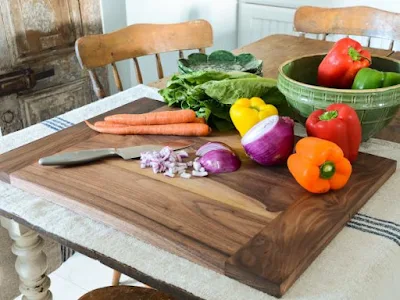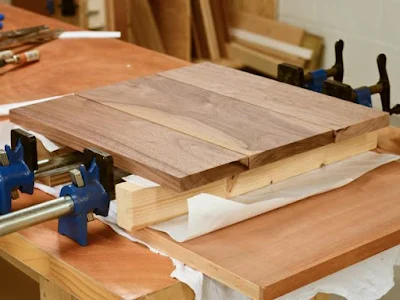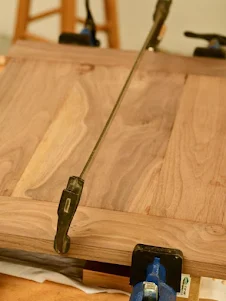DIY Wood Cutting Board: Personalize Your Kitchen with a Handcrafted Touch
A wooden cutting board is an essential tool in any kitchen. Not only does it provide a sturdy surface for cutting and chopping, but it also adds a touch of warmth and natural beauty to your countertop. While there are many cutting boards available for purchase, making your own DIY wooden cutting board can be a rewarding and cost-effective project. In this article, we'll guide you through the process of making your own custom wooden cutting board, from selecting the right wood to finishing and maintaining your board. So roll up your sleeves and let's get started on creating a beautiful and functional addition to your kitchen!
What do you need?
Precisely cut 3/4" dense hardwood with a closed grain (for ends: 2 pieces 16-1/8" x 3" and for center: 2 pieces 16" x 4-3/4", 1 piece 16" x 6-3/4")
Parchment paper
Scrap wood
Wood glue (waterproof and mildew-, solvent- and heat-resistant)
Rag
2 3-foot pipe clamp
4 12-inch bar clamps
1" chisel
Orbital sander
80-, 120- and 220-grit sanding pads
Food-safe finish like mineral oil, walnut oil or beeswax
What do you have to do?
Step 1: Assemble Wood
First, make sure wood isn't warped, is cut precisely and is smooth and square on all sides. Set two pieces of scrap wood (both the same size) on work surface. Place pieces of parchment paper over scrap wood to prevent cutting board pieces from sticking to scraps when glued. Place 16" x 6-3/4" piece in center with two 16" x 4-3/4" pieces on either side. Make sure to alternate the end grain to minimize warping; for example, the arc of the grain on the center piece should face up and the grain on the two end pieces should point down.
Tip: Purchase wood boards from a mill or cabinet shop (rather than a hardware store) to ensure your cutting board material has been cut precisely.
Step 2: Glue Board Center Together
Apply a bead of glue along one side of center piece of wood.
Quickly spread glue with a fingertip then lay it flat and butt against right-side piece
Apply glue to right side of left piece, spread with fingertip and butt against left side of center piece. Make sure edges are lined up.
Step 3: Clamp Boards
Clamp boards in place using two pipe clamps to press them together and four bar clamps to make sure joints are straight
Use small pieces of parchment paper when using clamps on a seam to prevent clamps from sticking to glue
Using a damp rag, wipe away any glue that squeezes out. Allow the board to remain clamped for several hours or overnight.
Step 4: Scrape Off Excess Glue
Once the glue has dried, remove the wooden cutting board from the clamps. Scrape off excess dried glue with a chisel, working gently to avoid marring the wood. Repeat this on all seams.
Tip: It is important to remove all traces of excess glue from wood before the food-safe finish is applied in the final step.
Step 5: Glue End Pieces
Line up end pieces along end grain of center pieces. Repeat steps 2 and 3.
Step 6: Finish Board
Once glue has dried, remove the cutting board from clamps. Scrape off any excess dried glue gently with a chisel. Using an orbital sander fitted with an 80-grit sanding pad, sand both sides of the board and edges to soften corners. Repeat sanding process with 120-grit, then 220-grit sandpaper. Make sure all dried glue is sanded off surface prior to finishing. Rub entire cutting board with several coats of a food-safe finish like mineral oil, walnut oil or beeswax, allowing oil to fully absorb into the wood. Allow cutting board to dry overnight before use.
Tip: As with most food-safe finishes, the cutting board finish will need to be reapplied regularly. If giving this board as a gift, also present the recipient with a bottle of oil as a companion gift along with care instructions.
By following the steps I will provide, you will be able to create a custom wood cutting board that perfectly suits your needs and preferences. This DIY project can be both enjoyable and rewarding as you will be able to design and craft a board that is functional and stylish for your kitchen.















Comments
Post a Comment